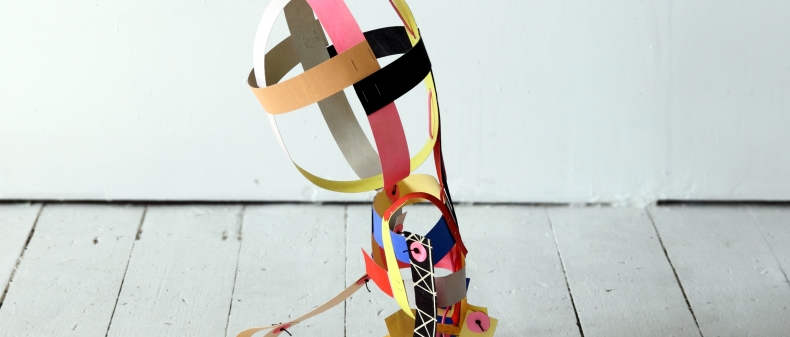
Detail from Libby Hague’s Puppet Child (2012)
Upon walking into Libby Hague’s new show at YYZ, it occurred to me how rare it is to see exclamation points in a show’s title. Usually, show titles read as cool and coded, abstract phrases that hint obliquely at a larger meaning. And the title of Hague’s show? Be Brave! We Are In This Together: an imperative buttressed by a collectivizing statement. It is at once funny, alarming and sad. It is funny simply because I don’t think I’ve ever encountered signage at a gallery commanding me to be brave (although, quite frankly, I can think of more than one instance where that would have been helpful).
Because of the way the gallery is laid out, one encounters the title before even peeking at the show. It braces you, commands you to buck up under the circumstances, whatever they might be. We are in this together: what is this? How long has this been going on? The title hints at an ongoing struggle, a kind of adventure, in which danger lurks around every corner and peril is sure to rear its ugly head at some point or other. On the one hand, it is redolent of children’s adventure movies, or the kind of sloganeering one encounters in comic books. On the other hand, if you take the title at all seriously, it assumes a tragic element; it becomes a motto against despair.
As it turns out, the title (with all that it implies) is indeed a perfect encapsulation of the show. The southern gallery of YYZ has been taken over by an elaborate mess of patterns, coloured papers, screenprinted and photocopied wallpapers, dollar-store silver netting and wrapping. And slowly, slowly, as one walks around the room, a kind of structure emerges. Figures appear first: bizarre puppets hang from the gallery ceilings (viewers are encouraged to move them, but carefully, as they’re quite delicate). They are joyfully crude: limbs made out of coloured papers, folded accordion-style; heads made out of thick bands of construction paper, rounded over and stapled together to suggest volume. They hang, limp and sagging, with the same wistful shrug as any lifeless puppet. A huge creature with tapering black and gold legs and a body consisting of a great triangular curlicued mass of drawn hair emerges from a corner.
The walls are covered in patterns: snaking lines, variously hued bands stacked one atop another that ring the gallery floor, huge prints of chain-link fence, the aforementioned silver netting, mirrored paper. These lines sometimes move off the wall, venturing hesitantly and haphazardly into the space. Every so often there is a bubbling cluster of crumpled paper, tightly ringed by another wide ribbon of paper, as if it were a crater peeking out of the floor or the wall, about to erupt.
According to the gallery statement, the immersive installation is meant as a kind of psychological self-portrait. I don’t know Hague well enough to attest to its accuracy, but with each successive tour of the room, with each tentative manipulation of these fragile puppets, I begin to see what she is getting at.
The first point of reference that popped into my head as I took in the show was children’s stories — Alice in Wonderland, The Wizard of Oz, Where the Wild Things Are, the films of Hayao Miyazaki — in which the character and fortitude of a plucky young protagonist is put to some kind of test, stories populated by a zoo of strange creatures. Hague’s installation has the feeling of just such a menagerie, and just such a premise. All of a sudden, the patterns on the wall begin to look like paths, and the colourful origami puppets seem like odd beings encountered on a journey: through a forest, down a rabbit hole, by a yellow brick road, in a magic kingdom simultaneously far, far away and as close as the inside of your mind.
The children’s story is, I think, the most apt system to describe the conceptual mechanisms of Hague’s installation. As in any such adventure tale, the façade of bright hues and wondrous creatures hides the various cruelties and psychological terrors implicit in a journey structured around change. Children’s books are invariably about the wonder and horror of growing older, of life’s ceaseless forward momentum. Hague’s installation, at first an explosion of colour and pattern and material, reveals this kind of narrative: paths are there to be chosen, each with their particular temptation, each one a different parade of characters, each one offering its own rewards and each one inflicting its own damages. In the end, Hague’s titular “This” is the map of a life; we all move through it at the same pace, day by day, year by year; we are all shaped and rewarded and damaged by the paths we choose and the people we meet. And we must all be brave, because we’re all in this together.
______
Sholem Krishtalka is the Toronto Standard’s art critic.
For more, follow us on Twitter at @torontostandard, and subscribe to our newsletter.











